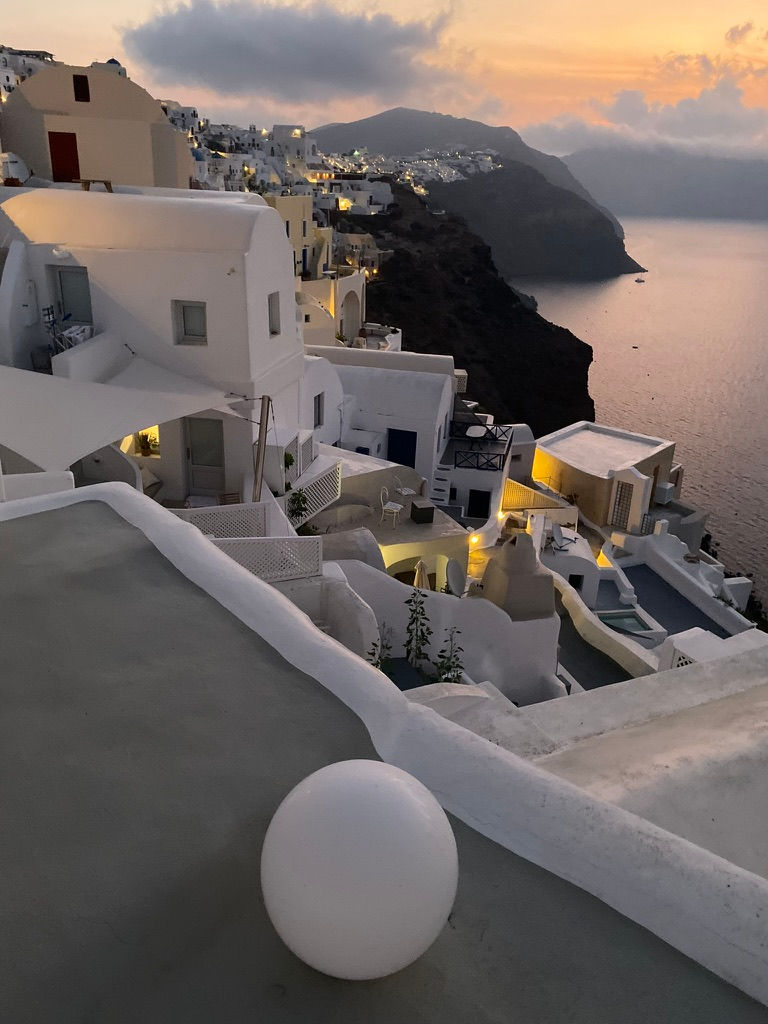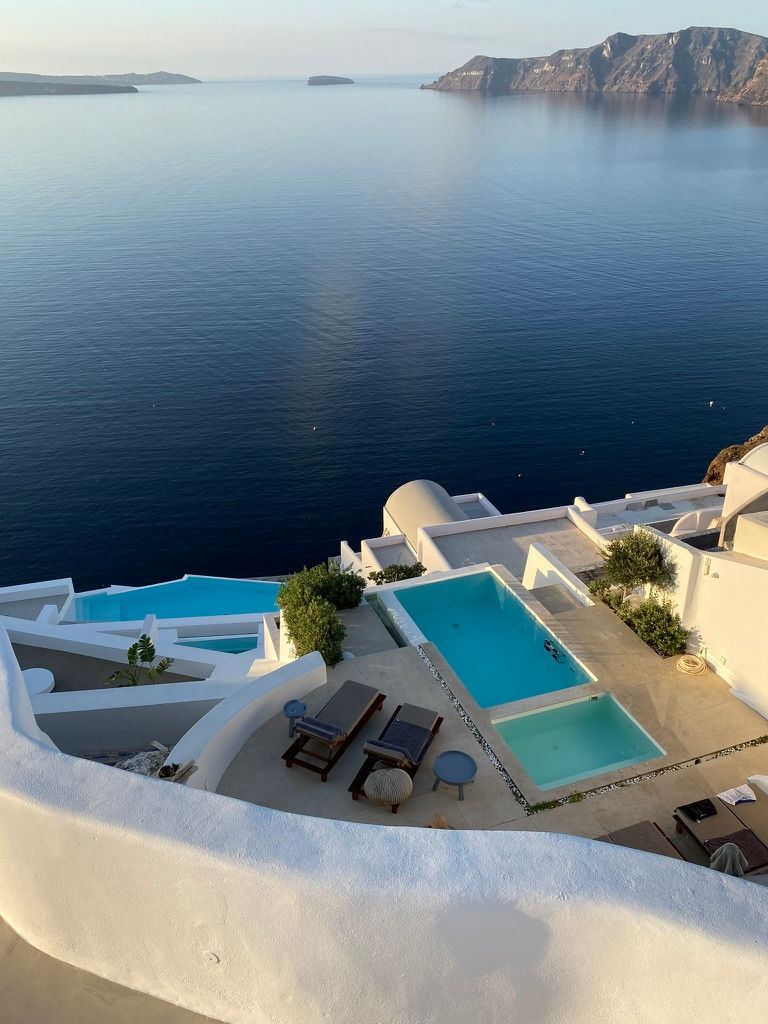SANTORINI: Island of Fire, Forms & Time
- Jon Hite

- Jun 18
- 5 min read
By Jon Hite | HAUS of HITE

There are places in the world that do not feel entirely earthly—places that seem to hang between the divine and the tangible. Santorini is one of them. Cradled in the Aegean Sea and shaped by fire, this island is both artifact and living sculpture, where millennia of upheaval and human ingenuity have given rise to one of the most iconic architectural landscapes in the world. Nowhere is this more evident than in Oia, a cliffside village that seems to spill toward the sea like a cascading dream of white and blue.
But to understand Santorini’s architecture is to first understand its violent birth.

A Land Forged by Cataclysm
Roughly 3,600 years ago, the island of Thera—as it was known in antiquity—was shattered by a volcanic eruption so violent that it changed the course of history. Entire portions of the island collapsed into the sea, forming the caldera that defines Santorini’s geography today. This eruption is thought to have wiped out the thriving Minoan civilization on nearby Crete and has long been tied to the legend of Atlantis. What remained was a crescent-shaped rim of land surrounding a deep, water-filled caldera—a crucible of fire and saltwater.
The eruption didn’t only reshape the island; it reshaped the way people lived on it. Volcanic rock and pumice became the materials of survival. Ancient builders, seeking protection from harsh winds and seismic threats, began carving their homes directly into the cliffs. These yposkafa—subterranean dwellings dug into the volcanic rock—offered natural insulation from both summer heat and winter chill.
Today, this tradition still endures, not as relic, but as lifestyle. In Oia, the past and present meet at every curve and corner. Whitewashed forms cling to the cliffs in poetic defiance of gravity, adapting to the island’s dramatic verticality.

The Architecture of Adaptation
Oia’s architecture is not built on the land but within it. Structures are curved and sculpted, not assembled. They follow the contours of the cliffs like flowing garments. Walls are rounded rather than angular, giving homes the feeling of having grown from the earth itself.

In the sunset-hued photograph of stacked facades and a tranquil pool, the interaction between light, form, and function feels elemental—an inheritance of ancient methods repurposed for contemporary comfort. This harmonious layering is a signature of Oia’s built environment, where light doesn’t just land—it lingers, sculpts, and sings.
This architectural style is not merely aesthetic. The island’s materials—volcanic ash, pozzolana, and pumice—are chosen for their thermal and seismic properties. White limewash reflects harsh sunlight. Flat roofs capture precious rainwater. Arched ceilings distribute pressure, reducing vulnerability to earthquakes.
Elsewhere on the island, a decorative iron gate opens to an endless view of the caldera. Its elegant patterning is both delicate and strong, a motif repeated throughout Cycladic design. It represents a threshold not just in space, but in experience—an invitation to cross from the familiar into the sublime.


From Empire to Earthquake: The Evolution of a Village
Santorini’s architecture, like its history, is layered. Venetian towers, Ottoman touches, and Orthodox churches have all left their mark. Under Venetian rule in the 13th century, fortified settlements emerged. Narrow paths and hidden stairways once functioned as a defense against pirates. These tight passages now guide today’s visitors through a sensory labyrinth of white walls, blooming bougainvillea, and glimpses of sapphire sea.
The earthquake of 1956 marked another turning point in Oia’s architectural story. Much of the village was destroyed. Rather than rebuilding in modern concrete forms, locals chose to restore the traditional yposkafa style, blending structural preservation with poetic continuity.
One image captures the interior of a restored cave house—soft stucco walls, vaulted ceilings, and windows perfectly framing the sea beyond. The design feels both ancient and alive. This continuity of form reminds visitors that Santorini is not frozen in time; it evolves, carefully and reverently, within the framework of its heritage.
Every surface seems shaped by hand and history. The tactile quality of carved staircases, weather-worn shutters, and patterned stone mosaics allude to centuries of craftsmanship passed through generations.

Living with Light
Light is perhaps the island’s greatest collaborator. It doesn’t simply illuminate Santorini—it animates it. In the image of layered terraces at dusk, white buildings blush in the warm hues of the setting sun. This interplay is not incidental—it’s foundational. The minimal palette of white, beige, and blue acts as a reflective surface for natural light, transforming each facade into a canvas of shifting mood and color.
Domes, a recurring feature of Santorini’s churches, rise above the rooftops like serene guardians of the caldera. Painted in vivid Aegean blue, they reflect the sky above and the sea below—mirroring the heavens, and perhaps, the gaze of the gods. While the island is rooted in Orthodox tradition, the mythology of the ancients still lingers faintly in the breeze. A nod to Aphrodite in the sea foam, or Apollo in the radiant sun.

Modern Memory, Ancient Rhythm
A modern infinity pool overlooks the caldera—a contemporary gesture that feels utterly timeless. The lines are clean, the color palette restrained, yet the essence remains deeply rooted. The same curves, the same reverence for setting. These are not flashy intrusions; they are quiet continuations of a conversation that began thousands of years ago.
Elsewhere, chipped gates and rough-hewn stone walkways show the beauty of imperfection. These details—the worn paint, the exposed textures—are what lend Santorini its soul. They’re reminders that even paradise ages. But in that aging, there’s intimacy, character, and truth.
The principles of sustainability are once again finding their way back into Santorini’s design language. Local materials, passive cooling, rainwater catchment—techniques that once emerged from necessity are now embraced as wisdom. In this way, Santorini not only preserves its past, it becomes a model for future-minded design.

Santorini’s Silent Narrative
What gives Santorini its power is not grandeur, but restraint. Its architecture is neither boastful nor ornamental for ornament’s sake. Instead, it is honest. It follows the lines of the earth and listens to the rhythms of the sea. It invites stillness.
A final image shows the rooftops of Oia at sunrise—curves, domes, and terraces unfolding toward the sea. This view, unchanged in essence for centuries, captures what Santorini has always offered: perspective. Whether you come for the architecture, the mythology, or simply the light, what you find here is a kind of remembering.
Not just of history. Of rhythm. Of reverence. Of the power in building with nature instead of against it.
And perhaps, as you pass through the curved doorways and descend the volcanic steps worn by time, you feel—if only for a moment—that you are part of something older, quieter, and more enduring than anything you left behind.





Comments